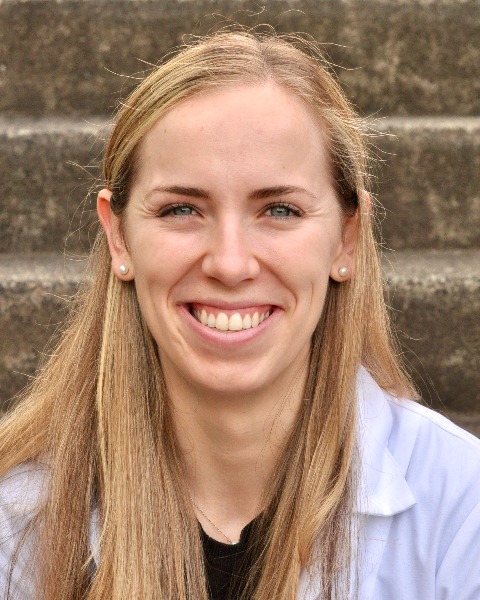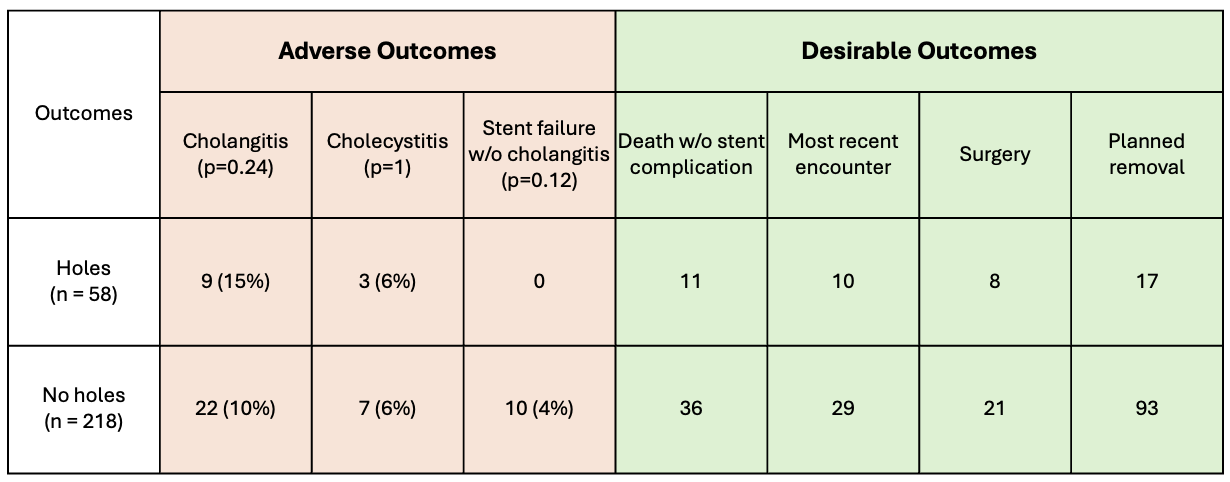Sunday Poster Session
Category: Biliary/Pancreas
P0028 - Side-Holed FCSEMS: Do They Mitigate Cholangitis and Cholecystitis Risk?
Sunday, October 26, 2025
3:30 PM - 7:00 PM PDT
Location: Exhibit Hall

Alexandra Stendahl (she/her/hers)
Oregon Health & Science University
Portland, OR
Presenting Author(s)
Alexandra Stendahl, , Kaveh Sharzehi, MD
Oregon Health & Science University, Portland, OR
Introduction: Fully covered self-expandable metal stents (FCSEMS) are commonly used to treat malignant and benign biliary strictures. While they have improved patency over uncovered metal and plastic biliary stents, data suggest they can increase the risk of cholecystitis due to cystic duct occlusion. FCSEMS with drainage side holes were designed to allow cystic duct drainage and reduce the risks, but their effectiveness in preventing cholecystitis is unclear. This study aimed to evaluate whether side holes reduce rates of cholecystitis or other adverse events.
Methods: We conducted a retrospective cohort study of adults who underwent ERCP with FCSEMS placement between April 2022 and April 2025 for malignant or benign strictures or post-sphincterotomy bleeding in a single institution. Patients whose stent was placed for a bile leak or without follow-up were excluded. Favorable stent endpoints included planned exchange, Whipple or other surgery, death without stent complication, or most recent encounter in the electronic medical record. Adverse outcomes included cholangitis, cholecystitis, or stent malfunction. Descriptive statistics, Fisher’s exact test, and t-tests were used to compare outcomes between stent types.
Results: Between April 2022 and April 2025, a total of 319 fully covered metal stents were placed. 43 stents were excluded due to indication of a bile leak or lack of follow up, with 276 stents ultimately analyzed. 58 of those stents had side holes (21%).
Rate of adverse events, cholangitis, and cholecystitis did not differ between stents with side holes and without side holes (Table 1).
Time to cholangitis and time to cholecystitis also did not differ between stents with side holes and stents without. Average time to cholangitis was 74 days in the holes group and 104 days in the no holes group (p = 0.39). Average time to cholecystitis was 92 days in the holes group and 84 days in the no holes group (p = 0.89).
Discussion: FCSEMS stents with side holes do not reliably reduce rates of adverse events, including cholecystitis or cholangitis compared to FCSEMS without side holes. Future directions include identifying other risk factors for cholangitis and cholecystitis such as tumor involvement of the cystic duct or presence of gallstones.

Figure: Table 1: Table showing the number of stents that had adverse endpoint or a desirable endpoint. For the cholecystitis group, percentages indicated are representative of those who have a gall bladder (n= 48 in the Holes group; n = 113 for the no holes group).
Disclosures:
Alexandra Stendahl indicated no relevant financial relationships.
Kaveh Sharzehi indicated no relevant financial relationships.
Alexandra Stendahl, , Kaveh Sharzehi, MD. P0028 - Side-Holed FCSEMS: Do They Mitigate Cholangitis and Cholecystitis Risk?, ACG 2025 Annual Scientific Meeting Abstracts. Phoenix, AZ: American College of Gastroenterology.
Oregon Health & Science University, Portland, OR
Introduction: Fully covered self-expandable metal stents (FCSEMS) are commonly used to treat malignant and benign biliary strictures. While they have improved patency over uncovered metal and plastic biliary stents, data suggest they can increase the risk of cholecystitis due to cystic duct occlusion. FCSEMS with drainage side holes were designed to allow cystic duct drainage and reduce the risks, but their effectiveness in preventing cholecystitis is unclear. This study aimed to evaluate whether side holes reduce rates of cholecystitis or other adverse events.
Methods: We conducted a retrospective cohort study of adults who underwent ERCP with FCSEMS placement between April 2022 and April 2025 for malignant or benign strictures or post-sphincterotomy bleeding in a single institution. Patients whose stent was placed for a bile leak or without follow-up were excluded. Favorable stent endpoints included planned exchange, Whipple or other surgery, death without stent complication, or most recent encounter in the electronic medical record. Adverse outcomes included cholangitis, cholecystitis, or stent malfunction. Descriptive statistics, Fisher’s exact test, and t-tests were used to compare outcomes between stent types.
Results: Between April 2022 and April 2025, a total of 319 fully covered metal stents were placed. 43 stents were excluded due to indication of a bile leak or lack of follow up, with 276 stents ultimately analyzed. 58 of those stents had side holes (21%).
Rate of adverse events, cholangitis, and cholecystitis did not differ between stents with side holes and without side holes (Table 1).
Time to cholangitis and time to cholecystitis also did not differ between stents with side holes and stents without. Average time to cholangitis was 74 days in the holes group and 104 days in the no holes group (p = 0.39). Average time to cholecystitis was 92 days in the holes group and 84 days in the no holes group (p = 0.89).
Discussion: FCSEMS stents with side holes do not reliably reduce rates of adverse events, including cholecystitis or cholangitis compared to FCSEMS without side holes. Future directions include identifying other risk factors for cholangitis and cholecystitis such as tumor involvement of the cystic duct or presence of gallstones.

Figure: Table 1: Table showing the number of stents that had adverse endpoint or a desirable endpoint. For the cholecystitis group, percentages indicated are representative of those who have a gall bladder (n= 48 in the Holes group; n = 113 for the no holes group).
Disclosures:
Alexandra Stendahl indicated no relevant financial relationships.
Kaveh Sharzehi indicated no relevant financial relationships.
Alexandra Stendahl, , Kaveh Sharzehi, MD. P0028 - Side-Holed FCSEMS: Do They Mitigate Cholangitis and Cholecystitis Risk?, ACG 2025 Annual Scientific Meeting Abstracts. Phoenix, AZ: American College of Gastroenterology.
